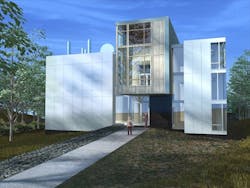Research with a View
BOSTON, MA - Payette, a leading architectural design firm specializing in complex buildings for medical and scientific research, academic teaching, and healthcare, has completed the 70,000-square-foot Gary C. Comer Geochemistry Building on the Lamont-Doherty Earth Observatory Campus for Columbia University in Palisades, NY.
A member of the Earth Institute, the Lamont-Doherty Earth Observatory (LDEO) is a leading research institution where research scientists seek fundamental knowledge about the origin, evolution, and future of the natural world. The new building includes laboratory space supporting research that, among other important contributions, has led the development of our understanding of climate change. Located on a dramatic site overlooking the Hudson River, the building includes specialized mass spectroscopy, geochemistry, and instrument-based laboratories. Divided into three parts, the north-facing lab zone is tied to a south-facing office zone through a central atrium area that accommodates group and interactive work.
"The opening of this new laboratory facility is an important step toward accelerating our efforts to understand the earth's dynamics and predict our planet's changing climate," said G. Michael Purdy, director of Lamont-Doherty Earth Observatory. "The visionary design combines the three primary attributes of a great and effective building: environmentally sound and energy-efficient architecture, an uncomplicated layout that is driven directly by the specific needs of the researchers, and a traffic pattern that will enhance important interactions between the many different groups of users. The opening of this new building is a landmark event for Lamont and for Columbia."
Payette opted to forgo the designated hillside site for the building, and turned instead to a former parking lot near the geochemistry division's existing home. Recognizing that three levels of naturally ventilated office space comfortably occupy the same building height as two levels of high technology laboratory space, Payette compacted the program into a single, 30-foot-high volume which minimizes the building's profile atop the Palisades escarpment.
A spine of common spaces, including meeting rooms, a videoconference center, lounge areas, and a 100-person seminar room, runs through the center of the building and emerges as a pair of elevated decks on its east side with stunning views of the Hudson River. Two top lit atriums with open switchback stairs connect the offset lab and office levels, and provide visual continuity for researchers as they move back and forth between the two wings.
While the building's plan is straightforward and well-suited for science, its "skip-stop" section arrangement transforms it into an unexpectedly dynamic place of varying scales and levels of intimacy. It takes maximum advantage of its spectacular site by framing exterior views wherever possible: each office features a floor-to-ceiling expanse of the hillside forest just feet away, and each laboratory includes a similarly broad prospect of the campus interior. All of the building's corridors terminate in either a double- or triple-height glazed overlook of the river valley. High clerestory windows flood the two atriums with abundant natural light.
Exterior materials reflect the building's internal organization. The office and lab wings feature aluminum curtainwall and aluminum panel facades, while the prominent central spine, with its slightly elevated and sloped roofline, is clad in zinc and teak elements which will develop a rich patina over time. Steel mesh gabions filled with Palisades basalt, a dark local stone, act as retaining walls where needed to mediate the existing topography.
Beyond the need to support the research, however, the design team took the work of the Earth Institute to heart and designed a building that focused on innovative environmental stewardship. Every major design decision from the placement of the building to the design of the office mechanical systems was reviewed for opportunities to push the environmental envelope. Importantly, these initiatives were pursued within a strict doctrine of cost control and limiting cutting-edge technology that might fail over the long haul. The resulting building is one that raises the bar on sustainability while still relying on everyday technology and normal construction practice.
